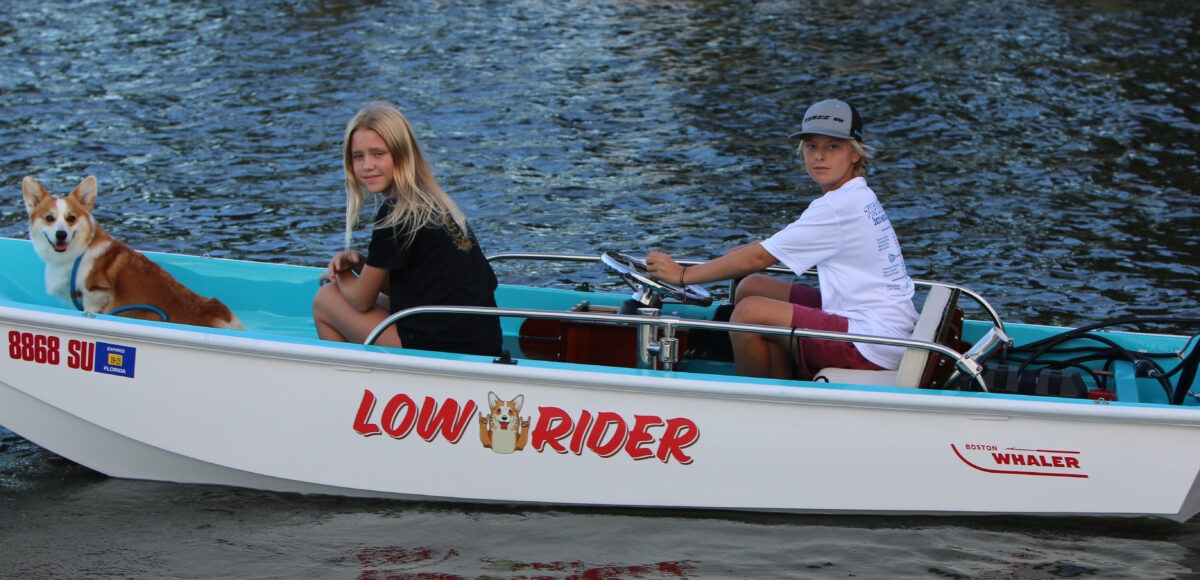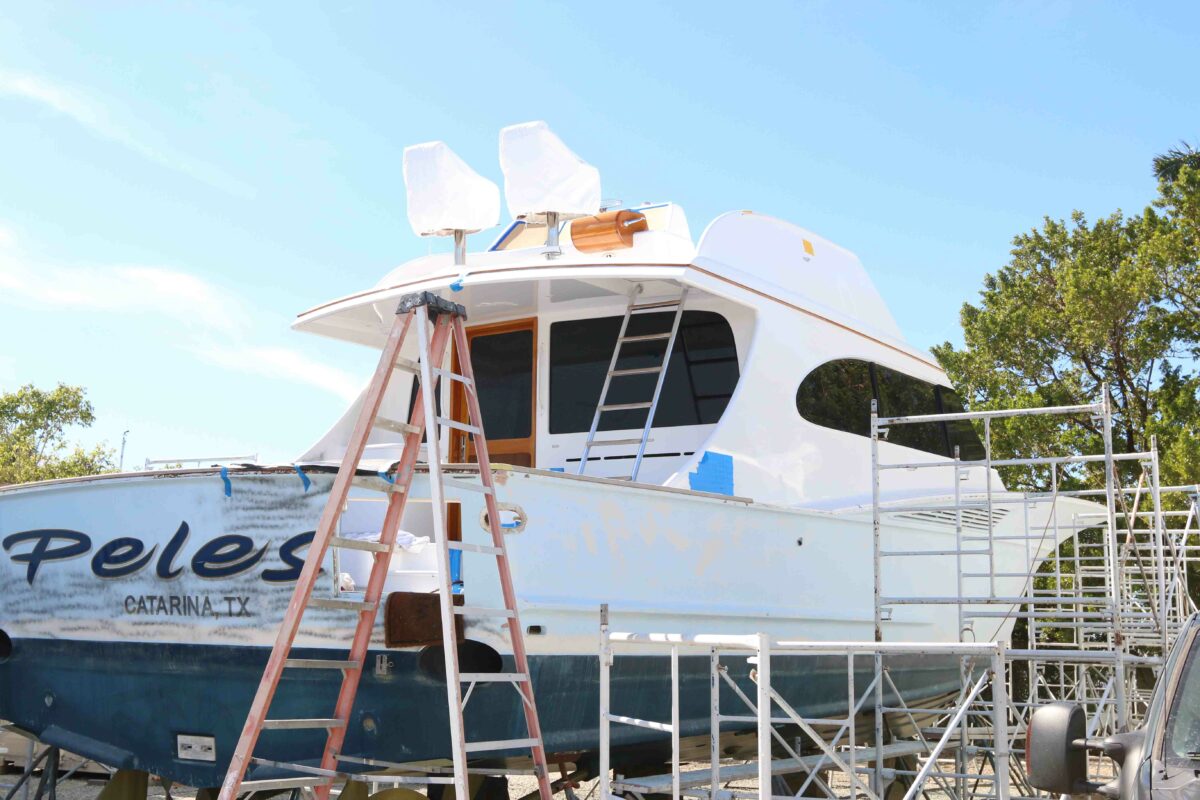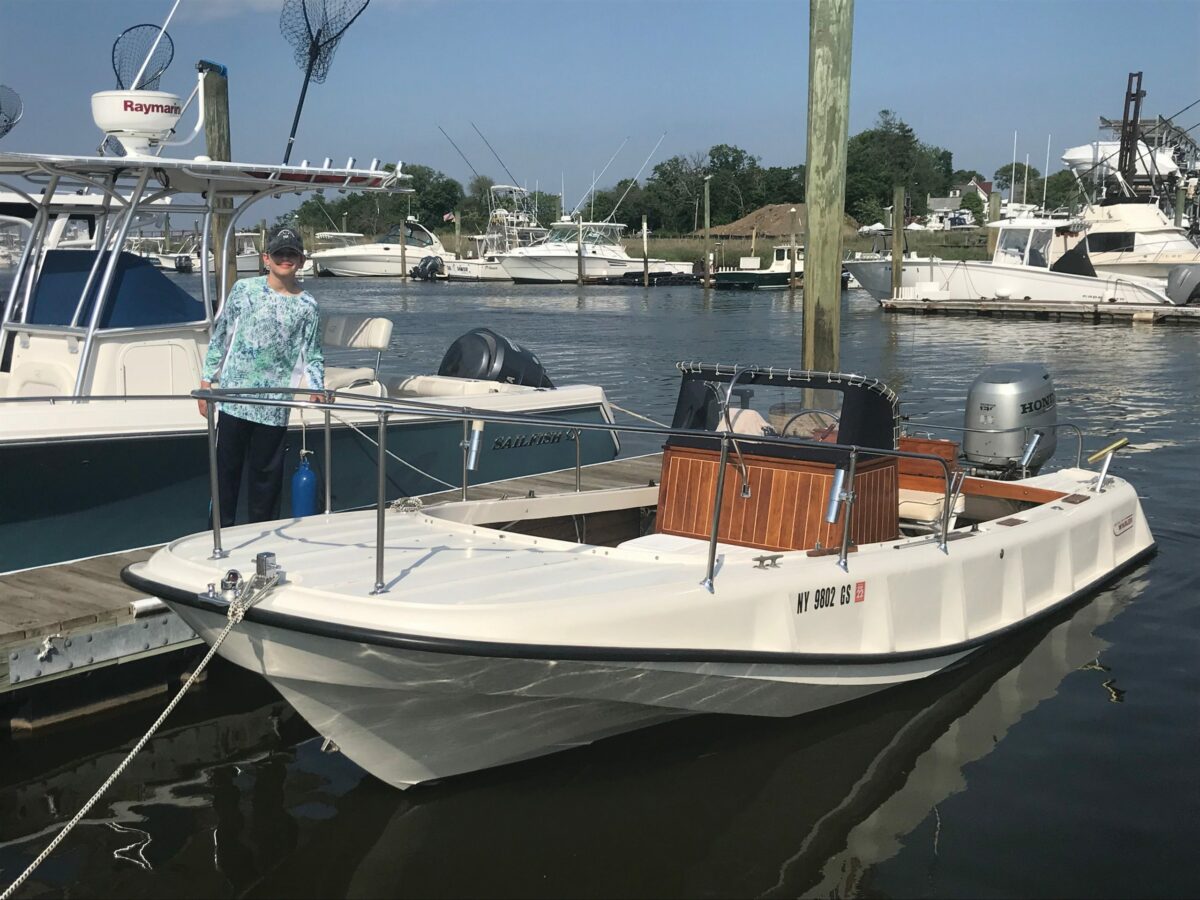Table of Contents
Starting Our Boating Journey
In 2021, I embarked on a quest to find a 13′ Whaler, driven by a clear goal: to introduce my then 10 and 11 year old kids to the world of boating. Leveraging my extensive boating background, I recognized that a 13′ Whaler held tremendous promise as the perfect entry-level vessel for several compelling reasons. Its unsinkable design offered unparalleled safety, and its compact size allowed the operator to grasp essential boating skills, such as navigating boat wakes, understanding the influence of wind and tides during docking, adjusting tilt and trim with a lightweight hull, and reaping the benefits of a shallow draft, among others. It truly represents an excellent choice for initiating any young aspiring boater.
Early Experiences and Deciding to Refurbish


Our vessel a 1967 13′ Whaler, acquired in 2021, featuring a 1979 Johnson 2-stroke motor with an electric choke. Upon acquisition, it exhibited extensive crazing across the interior, while the wooden console and seats seemingly retained their original state. The dated cable steering system showed signs of wear, and the boat’s underside bore numerous layers of bottom paint. Despite its age, the boat met our expectations. Initially, I intended to keep it in its purchased condition for my children’s enjoyment. However, after nearly a year of use, thoughts of undertaking what I thought would be a simple repowering and refurbishing project began to surface. The catalyst was a day on the water with my family when the 1979 2-stroke motor, though generally reliable, began exhibiting issues, especially after towing the kids on skimboards under the hot summer sun. Dealings with mixing fuel and oil for the two-stroke motor also became inconvenient, not to mention the motor smoked and was noisy. To compound matters, the steering cables had seen better days and didn’t inspire confidence in terms of safety. That’s when I decided to transform our beloved boat, lovingly named Low Rider. How challenging could it be?
The 13′ Boston Whaler Refit Begins
Upon removing the motor, steering pulleys, running lights, fuse panel, console, battery hold downs and anything else my Philips screwdriver could find, I found myself with a stripped hull. At that juncture, I hadn’t precisely determined the motor for the Whaler’s repower, but I was certain about one thing: I wanted to raise the transom to accommodate a 20′ motor and reduce the risk of rearward water inundation. (As you can see the older model transoms were designed for 15″ motors and had a lower central area on the transom).
Addressing the Transom and Deck
For the transom modification, I enlisted the expertise of a skilled fiberglass specialist who had assisted me in a prior boat project, Nazir Harjhoon with ANC Affordable Boat Repair who operates on the Treasure Coast of Florida, recommended the use of Coosa Composite Board for the transom alteration, ensuring it would be exceptionally robust while eliminating the need for marine plywood. Coosa Composite Board is well-regarded among reputable boat builders for its weight efficiency and overall strength and durability. Nazir executed the Coosa glassing into the transom masterfully.
Next, I turned my attention to the gel-coat on the gunnels, rear well area, and the deck, as it exhibited severe signs of crazing. The gunnel also featured original brass oar locks, which I decided to remove due to cracked gel coat surrounding them. My plan was to apply a non-skid paint additive to the deck, so I embarked on the laborious task of sanding and smoothing the entire deck surface. Additionally, there were holes on the deck from the previous battery hold downs, a bilge pump, and the console, all of which I needed to address. During this stage, I recognized the value of patience; I fiddled with sanding off and on when time permitted, which took way more time than expected, but it allowed the hull to sit in my garage for over three months to thoroughly air out and dry, eliminating any internal moisture.
The foredeck and forward compartment also demanded attention due to numerous cracks and crazing. To address this, I employed a dremel tool to meticulously grind out the cracks. Again, very time consuming.





Hull Restoration and Challenges
With the hull flipped, the primary task at hand was more sanding. The multiple layers of bottom paint had begun to chip, revealing signs of minor keel damage. As I meticulously sanded away the layers of bottom paint, I uncovered a few surprises beneath. Notably, there were a couple of previous repairs, evident by the epoxy resin covering them. I took the time to sand these down, revealing approximately two 4-inch holes, but fortunately, the foam inside the hull didn’t sustain any damage. On the port hull side, there was also evidence of damage, likely from rubbing against a dock.
Addressing the keel damage and holes required careful repair, but again taking more time than expected but allowing the hull to sit for a few more weeks to ensure that any trapped moisture within the foam had completely evaporated. After completing the necessary repairs, the process continued with further sanding, stripping away all the layers of paint down to the gel coat. Subsequently, more time transpired as the underside was meticulously faired and prepared for the next phase of the project.


Selecting and Applying the New Paint
After extensive preparation and multiple rounds of fairing, the Whaler was finally primed and ready for its fresh coat of paint. For this crucial step, I opted for Alexseal Yacht Coatings, known for their exceptional quality and durability. In my quest to maintain the authenticity of this 1967 Whaler, I reached out to their customer service team. I shared my restoration project details, emphasizing my desire to stay as true as possible to the original colors.
Following their expert guidance, I chose the Premium Topcoat 501 in Cloud White for the hull, ensuring it would recapture that classic look. To nail down the perfect “Whaler Blue” shade for the interior, I went with AD Blue, a formulation specifically designed for this iconic color.
To bring this vision to life, I entrusted Bruce Harris of Steadfast Marine in Port Saint Lucie, Florida, for the painting job. Bruce efficiently picked up the boat from my location, and within a week, he returned it, transformed with its fresh, vibrant colors.



Updating the Wood Components
When I acquired the Whaler, it was evident that the wood benches and helm needed attention. Initially, I had every intention of personally undertaking the laborious task of sanding and re-varnishing the wood components. However, as I delved deeper into the project, the time commitment became increasingly challenging to manage.
In search of a more efficient solution, I discovered Specialty Marine, a valuable resource for Whaler enthusiasts. After careful consideration, I made the decision to replace most of the wood components with new ones from Specialty Marine, with the exception of the two bench seats, which I chose to refinish. The choice to invest in new wood made economic sense, considering the considerable time and effort it would take to restore the original wood.
To ensure the longevity of the woodwork, I took an additional step with the beautifully varnished wood. Once I received the wood products, again I enlisted the expertise of Bruce Harris from Steadfast Marine to apply a protective coat of Alexseal Clear Coat. I can confidently recommend this extra measure for its added durability. In the short time we’ve enjoyed the boat, the clear coat has proven its worth by safeguarding the wood against scratches from wakeboards, skimboards, and fishing gear, bringing added peace of mind to our boating adventures.



Choosing the Right Motor
Throughout the entirety of the refit process, I carefully considered various motor options, each weighed against a set of specific criteria. Firstly, I aimed to keep the motor’s weight in close proximity to the 1979 Johnson 35 hp I had removed. This choice was vital to ensure that the boat’s performance remained consistent and that we didn’t introduce excessive weight to the transom area. These 13-footers are notoriously sensitive to weight distribution, and I had seen far too many instances where 13’s sagged dangerously in the transom region with excessive horsepower.
Secondly, I kept in mind that the boat would primarily be used by kids, so there was no need for blistering speeds. What I did want, however, was the convenience of electric start, tilt and trim.
After extensive research and consideration, I settled on the Tohatsu 30 hp 4-stroke motor in a clean white finish with a Odyssey battery from St Lucie Battery & Tire. This engine, weighing a mere 128 lbs, proved to be an exceptional choice. The motor runs remarkably quietly and the fuel economy is exceptional. When the kids take to skimboarding, the boat effortlessly pulls two at a time and quickly planes. The Whaler cruises comfortably at around 23 knots and can hit over 30 knots at full throttle.









I’d like to thank the following vendors for their help with this project. InTheBite Publisher Dale Wills
Alexseal Yacht Coatings https://www.alexseal.com/
Tohatsu https://www.tohatsu.com/marine/na/
Bruce Harris from Steadfast Marine Ph: 772-201-8911
Nazir Harjhoon with ANC Affordable Boat Repair Ph: 772-359-6058
Northeast Marine Clearwater, Fl https://www.northeastmarine.net/
St Lucie Battery & Tire https://slbatterytire.com/
Specialty Marine for 13’ Whaler Parts https://www.specialtymarine.com/
Don’t Forget to Check Out Our Sportfishing Job Board! Did You Know? It’s the perfect platform for seeking skilled captains and mates. Whether you’re on the hunt for your dream team or looking to join one, your next big adventure begins here. Explore the opportunities now! Click Here
Dive Deeper into the World of Sportfishing
Unlock Exclusive Savings: Enjoy 50% Off Your Subscription!
Are you ready to explore the thrilling world of sportfishing from the comfort of your home? Subscribe now and embark on a journey filled with captivating stories, expert insights, and insider tips. Choose between our digital or print edition and secure an incredible 50% discount on your subscription.
Subscribe today and get ready for an adventure like no other. Click here to subscribe and elevate your sportfishing experience with InTheBite Sportfishing Magazine.














